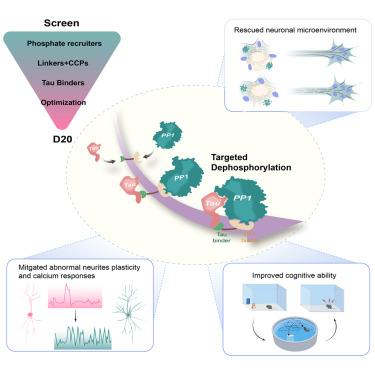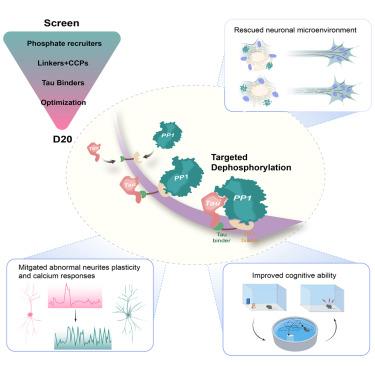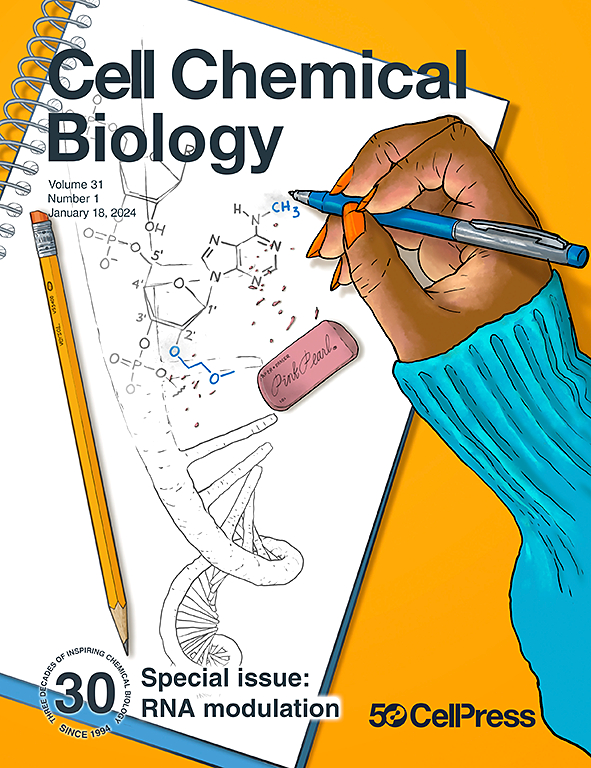A tau dephosphorylation-targeting chimeraselectively recruits protein phosphatase-1 to ameliorate Alzheimer’s disease and tauopathies
IF 6.6
1区 生物学
Q1 BIOCHEMISTRY & MOLECULAR BIOLOGY
引用次数: 0
Abstract
Abnormal accumulation of hyperphosphorylated tau (pTau) is a major cause of neurodegeneration in Alzheimer’s disease (AD) and related tauopathies. Therefore, reducing pTau holds therapeutic promise for these diseases. Here, we developed a chimeric peptide, named D20, for selective facilitation of tau dephosphorylation by recruiting protein phosphatase 1 (PP1) to tau. PP1 is one of the active phosphatases that dephosphorylates tau. In both cultured primary hippocampal neurons and mouse models for AD or related tauopathies, we demonstrated that single-dose D20 treatment significantly reduced pTau by dephosphorylation at multiple AD-related sites and total tau (tTau) levels were also decreased. Multiple-dose administration of D20 through tail vein injection in 3xTg AD mice effectively ameliorated tau-associated pathologies with improved cognitive functions. Importantly, at therapeutic doses, D20 did not cause detectable toxicity in cultured neurons, neural cells, or peripheral organs in mice. These results suggest that D20 is a promising drug candidate for AD and related tauopathies.


牛头去磷酸化靶向嵌合酶选择性招募蛋白磷酸酶-1,改善阿尔茨海默病和牛头病的病情
高磷酸化 tau(pTau)的异常积累是阿尔茨海默病(AD)和相关 tau 病神经变性的主要原因。因此,降低 pTau 有望治疗这些疾病。在这里,我们开发了一种名为D20的嵌合肽,通过将蛋白磷酸酶1(PP1)招募到tau上,选择性地促进tau去磷酸化。PP1是使tau去磷酸化的活性磷酸酶之一。我们在培养的原代海马神经元和AD或相关tau病小鼠模型中证实,单剂量D20治疗可通过在多个AD相关位点去磷酸化而显著降低pTau,总tau(tTau)水平也会降低。在 3xTg AD 小鼠中通过尾静脉注射多剂量 D20 能有效改善与 tau 相关的病理现象,并改善认知功能。重要的是,在治疗剂量下,D20 不会对小鼠的培养神经元、神经细胞或外周器官产生可检测到的毒性。这些结果表明,D20是一种很有前景的候选药物,可用于治疗AD和相关的tau病症。
本文章由计算机程序翻译,如有差异,请以英文原文为准。
求助全文
约1分钟内获得全文
求助全文
来源期刊

Cell Chemical Biology
Biochemistry, Genetics and Molecular Biology-Molecular Medicine
CiteScore
14.70
自引率
2.30%
发文量
143
期刊介绍:
Cell Chemical Biology, a Cell Press journal established in 1994 as Chemistry & Biology, focuses on publishing crucial advances in chemical biology research with broad appeal to our diverse community, spanning basic scientists to clinicians. Pioneering investigations at the chemistry-biology interface, the journal fosters collaboration between these disciplines. We encourage submissions providing significant conceptual advancements of broad interest across chemical, biological, clinical, and related fields. Particularly sought are articles utilizing chemical tools to perturb, visualize, and measure biological systems, offering unique insights into molecular mechanisms, disease biology, and therapeutics.
 求助内容:
求助内容: 应助结果提醒方式:
应助结果提醒方式:


